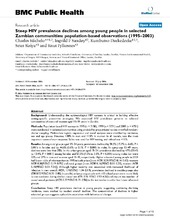| dc.description.abstract | Background: Understanding the epidemiological HIV context is critical in building effective setting-specific preventive strategies. We examined HIV prevalence patterns in selected communities of men and women aged 15–59 years in Zambia. Methods: Population-based HIV surveys in 1995 (n = 3158), 1999 (n = 3731) and 2003 (n = 4751) were conducted in selected communities using probability proportional to size stratified random-cluster sampling. Multivariate logistic regression and trend analyses were stratified by residence, sex and age group. Absence, <30% in men and <15% in women in all rounds, was the most important cause of non-response. Saliva was used for HIV testing, and refusal was <10%. Results: Among rural groups aged 15–24 years, prevalence declined by 59.2% (15.7% to 6.4%, P < 0.001) in females and by 44.6% (5.6% to 3.1%, P < 0.001) in males. In age-group 15–49 years, declines were less than 25%. In the urban groups aged 15–24, prevalence declined by 47% (23.4% to 12.4%, P < 0.001) among females and 57.3% (7.5% to 3.2%, P = 0.001) among males but were 32% and 27% in men and women aged 15–49, respectively. Higher educated young people in 2003 had lower odds of infection than in 1995 in both urban [men: AOR 0.29(95%CI 0.14–0.60); women: AOR 0.38(95%CI 0.19–0.79)] and rural groups [men: AOR 0.16(95%CI 0.11–0.25), women: AOR 0.10(95%CI 0.01–7.34)]. Although higher mobility was associated with increased likelihood of infection in men overall, AOR, 1.71(95%CI 1.34–2.19), prevalence declined in mobile groups also (OR 0.52 95%CI 0.31–0.88). In parallel, urban young people with ≥11 school years were more likely to use condoms during the last casual sex (OR 2.96 95%CI 1.93–4.52) and report less number of casual sexual partners (AOR 0.33 95%CI 0.19–0.56) in the last twelve months than lower educated groups. Conclusion: Steep HIV prevalence declines in young people, suggesting continuing declining incidence, were masked by modest overall declines. The concentration of declines in higher educated groups suggests a plausible association with behavioural change. | en_US |

